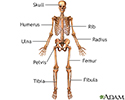Acrodysostosis
Arkless-Graham; Acrodysplasia; Maroteaux-Malamut
Acrodysostosis is an extremely rare disorder that is present at birth (congenital). It leads to problems with the bones of the hands, feet, and nose, and intellectual disability.
Causes
Most people with acrodysostosis have no family history of the disease. However, sometimes the condition is passed down from parent to child. Parents with the condition have a 1 in 2 chance of passing the disorder to their children.
There is a slightly greater risk with fathers who are older.
Symptoms
Symptoms of this disorder include:
-
Frequent middle
ear infections
Ear infections
Otitis is a term for infection or inflammation of the ear.
 ImageRead Article Now Book Mark Article
ImageRead Article Now Book Mark Article - Growth problems, short arms and legs
- Hearing problems
- Mental deficiency
- The body doesn't respond to certain hormones, even though hormone levels are normal
- Unusual looking face
Exams and Tests
The health care provider can usually diagnose this condition with a physical exam. This may show:
- Advanced bone age
- Bone deformities in hands and feet
- Delays in growth
- Problems with the skin, genitals, teeth, and skeleton
- Short arms and legs with small hands and feet
- Short head, measured front to back
- Short height
- Small, upturned broad nose with flat bridge
- Unusual features of the face (short nose, open mouth, jaw that sticks out)
- Unusual head
- Wide-spaced eyes, sometimes with extra skin fold at corner of eye
In the first months of life, x-rays may show spotty calcium deposits, called stippling, in bones (especially the nose). Infants may also have:
- Abnormally short fingers and toes
- Early growth of bones in the hands and feet
- Short bones
- Shortening of the forearm bones near the wrist
Two genes have been linked with this condition, and genetic testing may be done.
Treatment
Treatment depends on the symptoms.
Hormones, such as growth hormone, may be given. Surgery to treat bone problems may be done.
Outlook (Prognosis)
Problems depend on the degree of skeletal involvement and intellectual disability . In general, people do well.
Intellectual disability
Intellectual disability is a condition diagnosed before age 18 that includes below-average intellectual function and a lack of skills necessary for d...
Possible Complications
Acrodysostosis may lead to:
-
Arthritis
Arthritis
Arthritis is inflammation of one or more joints. A joint is the area where 2 bones meet. There are more than 100 different types of arthritis....
 ImageRead Article Now Book Mark Article
ImageRead Article Now Book Mark Article -
Carpal tunnel syndrome
Carpal tunnel syndrome
Carpal tunnel syndrome is a condition in which there is excessive pressure on the median nerve. This is the nerve in the wrist that allows feeling a...
 ImageRead Article Now Book Mark Article
ImageRead Article Now Book Mark Article - Worsening range of movement in the spine, elbows, and hands
When to Contact a Medical Professional
Call your child's provider if signs acrodystosis develop. Make sure your child's height and weight are measured during each well-child visit. The provider may refer you to:
- A genetic professional for a full evaluation and chromosome studies
- A pediatric endocrinologist for management of your child's growth problems
References
Jones KL, Jones MC, Del Campo M. Other skeletal dysplasias. In: Jones KL, Jones MC, Del Campo M, eds. Smith's Recognizable Patterns of Human Malformation . 7th ed. Philadelphia, PA: Elsevier Saunders; 2013:560-593.
Silve C, Clauser E, Linglart A. Acrodysostosis. Horm Metab Res . 2012;44(10):749-758. PMID: 22815067 www.ncbi.nlm.nih.gov/pubmed/22815067 .
-
Anterior skeletal anatomy - illustration
The skeleton is made up of 206 bones in the adult and contributes to the form and shape of the body. The skeleton has several important functions for the body. The bones of the skeleton provide support for the soft tissues. For example, the rib cage supports the thoracic wall. Most muscles of the body are attached to bones which act as levers to allow movement of body parts. The bones of the skeleton also serve as a reservoir for minerals, such as calcium and phosphate. Finally, most of the blood cell formation takes places within the marrow of certain bones.
Anterior skeletal anatomy
illustration
-
Anterior skeletal anatomy - illustration
The skeleton is made up of 206 bones in the adult and contributes to the form and shape of the body. The skeleton has several important functions for the body. The bones of the skeleton provide support for the soft tissues. For example, the rib cage supports the thoracic wall. Most muscles of the body are attached to bones which act as levers to allow movement of body parts. The bones of the skeleton also serve as a reservoir for minerals, such as calcium and phosphate. Finally, most of the blood cell formation takes places within the marrow of certain bones.
Anterior skeletal anatomy
illustration
Review Date: 10/30/2016
Reviewed By: Anna C. Edens Hurst, MD, MS, Assistant Professor in Medical Genetics, The University of Alabama at Birmingham, Birmingham, AL. Review provided by VeriMed Healthcare Network. Also reviewed by David Zieve, MD, MHA, Isla Ogilvie, PhD, and the A.D.A.M. Editorial team.

